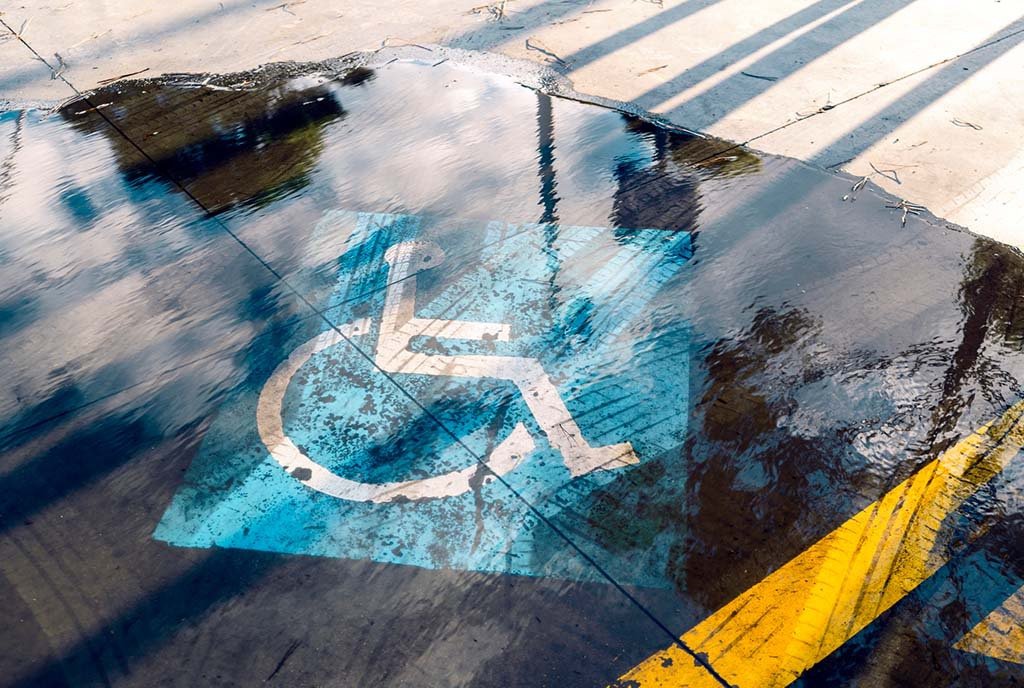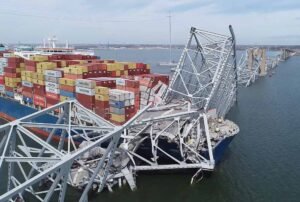
Norma Crosby realized her house was flooding when she was sitting at her dining room table and noticed her toes were wet. She knew Hurricane Harvey might hit her rural town of Alvin, TX, but it wasn’t until the water reached her feet that she knew she and her husband had to evacuate. They listened to the news of the storm through the National Federation of the Blind Newsline, which gives newspaper access and emergency weather alerts to blind and vision-impaired people. Soon after, a friend called the Crosbys to let them know that she would pick them up. By the time they walked to the car, canes in hand, the floodwater was up to their waists.
Disabled people face distinct struggles in preparing for and dealing with climate disasters, from difficulty evacuating to issues accessing medication or emergency-related information. In 2022, there were 18 climate disasters in the United States, including wildfires, floods, and cyclones. The number and intensity of climate disasters, as well as the associated cost to the nation, are increasing at a rate alarming to the scientific community and beyond. Last year, 474 people died due to climate disasters, and studies show people with disabilities are two to four times more likely to die or be critically injured in them. But these statistics are preventable: bringing people with disabilities into the design process around climate- and disaster-assistance policy could help create more inclusive systems that leave no one behind.
Disabled people face distinct struggles in preparing for and dealing with climate disasters, from difficulty evacuating to issues accessing medication or emergency-related information.
Getting Out Is the Biggest Problem
Crosby, 67, who is the President of the National Federation of the Blind of Texas (NFBT), sees the importance of community when she looks back on Hurricane Harvey. The friend who picked her up during the storm and other blind people who checked on her as the weather worsened were key to her safety. Crosby says she and her husband prepared for the hurricane in many of the ways that nondisabled people do, like making sure they had their important papers in a safe place. But some of the challenges are markedly different.
“One of the biggest issues is transportation,” Crosby says. “Especially for low-income blind people who may not have access to that friend that’s going to come pick them up or don’t have family support. Often, getting out is the biggest problem we face.”
Cassie Wilson, a 24-year-old student from Boring, OR, who has a form of dwarfism and uses mobility aids, also worries about transportation. In September 2020, a historic windstorm caused five megafires to sweep across the state. Wilson, who uses pedal extenders when operating a vehicle, was still learning to drive when the fires rolled in. She worried about being able to safely drive herself and her mother through the thick smoke. Her concerns compounded before they even reached the car—Wilson’s mother, also chronically ill, needed to take frequent breaks when loading the car while Wilson was unable to help.
“Everything [is] harder when you’re disabled,” Wilson says. She needs assistance putting on her shoes. This elevated her concerns about potential middle-of-the-night evacuations. If there wasn’t time for her mother to help put on her shoes, would Wilson just grab them and drive barefoot? How would the duo load her scooter into the car? Would her mother remember all her medications?
“We have prepared as much as we can…and now it’s the classic disabled thing of being able to adapt to any situation or circumstance that may arise unexpectedly.”
With limited information about when to leave and the best way to ensure their safety, Wilson and her mother had to make a choice. “In the [official] guidance, there was nothing about disabled people or people who may need extra time to evacuate,” she says. They decided to drive the 90 minutes to Wilson’s grandparents’ house in Washington state.
As they drove, Wilson was haunted by the possibilities. “All I could think about was the news stories about disabled people being left behind in disasters,” she reflects, “and being terrified of being the next person to be left behind.” She drove, exhausted, watching the smoke roll over her town and wondering what her street would look like when they returned.
Now, Wilson and her mother have developed a system they deploy each summer for fire season. They have an emergency kit with dollar bills for the tolls between Oregon and Washington and go-bags with medication and extra clothes. Still, Wilson worries: “There’s only so much you can do. We have prepared as much as we can…and now it’s the classic disabled thing of being able to adapt to any situation or circumstance that may arise unexpectedly.”
A New Social Safety Net
According to Michael Stein, a visiting professor at Harvard, people with disabilities are not only more affected long-term socioeconomically by climate change, they’re also the most vulnerable immediately after disasters. Studies show that people with disabilities are more likely to be poorer and less educated than their nondisabled counterparts, and disability of any member of a family can affect the socioeconomic status of the entire family unit. And people with lower incomes are more likely to be adversely affected by climate disasters.
The lack of federal resources for people with disabilities during climate disasters is stark. And it’s an issue that will only become more prevalent as the rate of disasters increases. There are potential legislative interventions in the works, including the Real Emergency Access for Aging and Disability Inclusion (REAADI) for Disasters Act, which was reintroduced earlier this year to the House and Senate. The REAADI Act would make sure that individuals relocated due to climate disasters still have access to all Medicaid-related services by providing 100 percent federal coverage. This legislation would not only provide these missing services but also create a National Commission on Disability Rights and Disaster to further study the needs of disabled people and offer solutions.
Sign up for our free newsletters
Subscribe to NPQ's newsletters to have our top stories delivered directly to your inbox.
By signing up, you agree to our privacy policy and terms of use, and to receive messages from NPQ and our partners.
Bringing disabled people into the design process around climate policy is not just a matter of inclusivity, it is a matter of designing systems that leave no one behind.
Despite the current lack of federal legislation, there are national and international organizations working to help disabled people affected by climate disasters. The Federal Emergency Management Agency (FEMA) has an Office of Disability Integration and Coordination. Also at the national level, the Partnership for Inclusive Disaster Strategies is a disability-led organization that has most recently played a large role in helping disabled people affected by both the Maui wildfires and Hurricane Idalia.
Beyond the United States, SustainedAbility, a network focused on the intersection between disability issues and climate justice, has provided important, disability-led leadership within the United Nations Framework Convention on Climate Change since 2017, focusing especially on creating a constituency of disabled people that can bring their voices to negotiations around climate sustainability and planning for the one billion people in the world who are living with disabilities.
Less specifically focused on climate change but similarly focused on convening groups across nations, the International Disability Alliance—made up of 14 disability organizations around the world—brings the voices of disabled people to the table at the United Nations “for a more inclusive global environment for everyone.” Bringing disabled people into the design process around climate policy is not just a matter of inclusivity, it is a matter of designing systems that leave no one behind.
Preparing for the Worst
Despite these efforts, there are still significant gaps in resources available on the ground, so community-based organizations have been at the forefront of helping disabled people prepare for climate disasters. Shari Myers, the disaster operations coordinator for the Partnership for Inclusive Disaster Strategies, says that emergency management plans often don’t consider people with disabilities.
Myers notes that issues range from shelters not being accessible to disaster alerts not being tailored to reach people who may not be able to see or hear. It’s critical, according to Myers, that institutions planning emergency responses include disabled people in conversations: “We’re the experts. We know how to best support us during a disaster and how to maintain our independence.”
Myers and other activists offer strategies for disabled people to prepare for the worst:
Create a list of medications. Though many disaster relief organizations may urge people to keep a stockpile of their medication, Myers says that’s often impossible. Some disaster management groups have mechanisms in place to replace medication, but Myers suggests also keeping a list of necessary medications and regularly used pharmacies.
Assemble a go-bag. In case of emergency, it’s helpful to have a bag already packed with essentials like medication, batteries, a flashlight, and a first-aid kit. “Make sure you know where your candles, matches, and nonperishable foods are,” Myers says. She also recommends downloading the Red Cross Emergency app, which she finds to be more inclusive.
Keep equipment fully charged if possible. Alice Wong, a 49-year-old activist and author who lives in the Bay Area, has experienced earthquakes, wildfires, and atmospheric rivers, which are concentrated clouds of moisture that deliver heavy rain or snow. “The level of anxiety and anticipation is greater for me during environmental disasters because I know how acutely vulnerable I am,” she says. “Disabled people live in precarity because we face systemic ableism and a world that wasn’t built for us.” She tries to keep her ventilator, wheelchair, and feeding machine fully charged in case of a power outage, with backup batteries in place.
Lean on your community. In a climate disaster, it’s critical for people with disabilities to have a support network they can call on. Myers shares that nondisabled people can help disabled people by checking in on them or helping them evacuate. Crosby says the approach can be simple: ask them what they need. “Make it their choice,” she says. “Give the blind person the respect and dignity of saying, ‘Hey, I want to help, tell me what you need.’”









